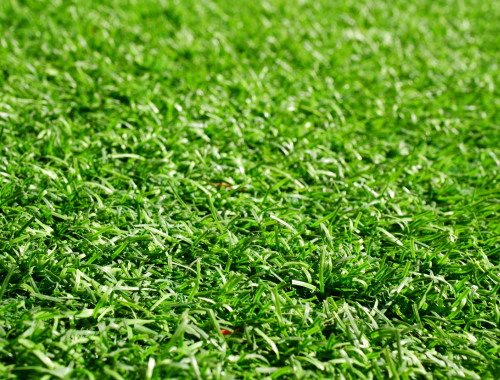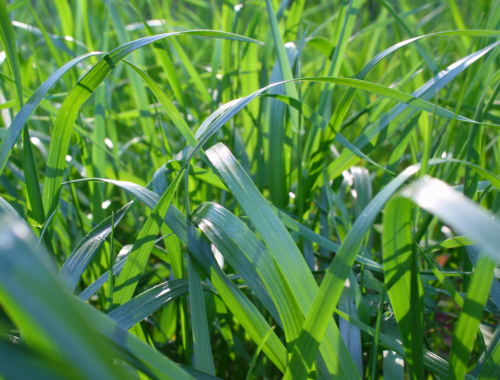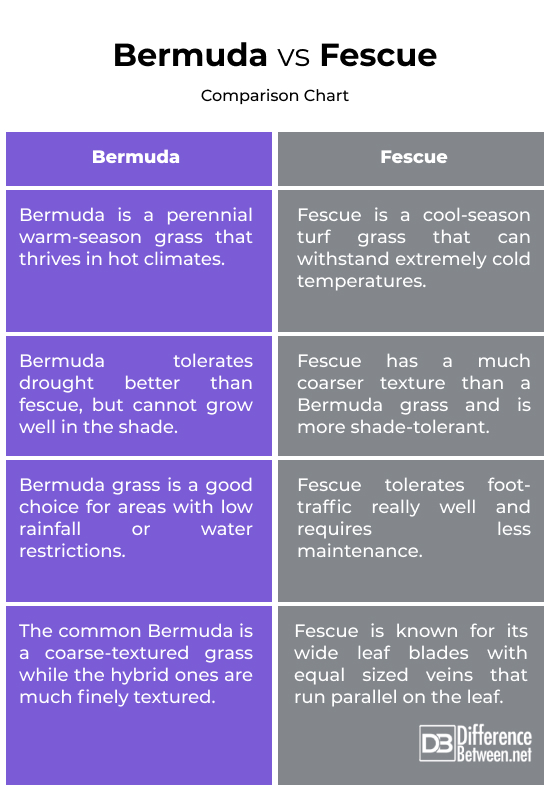Difference Between Bermuda and Fescue
A well-kept lawn is much more than just a patch of grass; it’s a thing of beauty and a source of pride. Nothing adds a home curb’s appeal better than a well-maintained, lush green lawn. However, there’s one reality that is very important to lawns, one that you cannot ignore. A beautiful lawn takes a lot of work to maintain properly. But before getting into lawn care and maintenance, it’s very important to understand the different types of grass first. Grasses are the primary component of most lawns that enhances the beauty of your property if maintained with utmost care. For a healthy and appealing lawn, choosing the right grass is equally crucial. The two most common types of grasses commonly used for lawns are Bermuda and Fescue.

Bermuda
Bermuda is a perennial warm-season grass that is native to Africa, Australia, Europe, and much of Asia. It is one of the common types of lawn grass that is also used extensively as a turf grass in golf courses and sports fields. The common Bermuda is a coarse-textured grass while the hybrid ones are much finely textured. As an exotic, Bermuda grows best in hot temperature and is often found in Southern regions. It spreads from seed or stolons or is planted as sod. It grows quickly to produce a vigorous, impenetrable turf of tough roots and dense blades. It is drought-resistant and requires water only once a week.

Fescue
Fescue is a widely used, cool-season turf grass that can withstand extremely cold temperatures and drought. It is an exotic grass native to Europe and is best known for its unique blades and growing patterns. It has a much coarser texture than a Bermuda grass and is more shade-tolerant, which means it thrives well in densely shaded areas. This is the reason Fescue is one of the most desirable choices as a turf grass, thanks to its ability to stay lush green all year long. Fescue grass is taller and can reach up to 4 inches in height. Because of its ability grow in a wide range of climates, Fescue is a popular choice among homeowners.
Difference between Bermuda and Fescue
Growing Conditions
– Bermuda is a perennial warm-season grass that thrives in hot climates and goes dormant in cold weather. Bermuda grows best in hot temperature and is often found in Southern regions. Fescue, on the other hand, is a cool-season turf grass that can withstand extremely cold temperatures but is well-suited for both warm and cool climate areas. Fescue is commonly known as tall fescue because it is taller.
Heat and Drought Tolerance
– Bermuda is a deep-rooted grass that can survive extended periods of drought. Bermuda tolerates drought better than fescue and it requires moderate watering to keep growing. However, Bermuda isn’t the type of grass that grows well in the shade. Fescue grass is more shade tolerant than Bermuda grass, but it is less tolerant to drought which means it requires frequent watering to grow and stay healthy.
Characteristics
– The common Bermuda is a coarse-textured grass while the hybrid ones are much finely textured. It has a dense, hardy growth pattern and it grows quickly to form an impenetrable mat of tough roots and dense blades. Fescue is known for its wide leaf blades with equal sized veins that run parallel on the leaf. Fescue can grow taller up to 4 inches and is able to grow in a wide range of climates.
Maintenance
– Bermuda spreads from seed or stolons or is planted as sod. It is slightly more durable and can repair itself when damaged by kids or pets. It requires average to high maintenance depending on the type and 4 to 6 feedings per year, depending on length of growing season. It requires more intensive care and can be mowed down from ½ inches to 2 inches. Fescue tolerates foot-traffic really well and requires less maintenance than Bermuda grass. It has a slower growth rate, so it requires less mowing. Mowing height should be 2.5 to 3 inches.
Bermuda vs. Fescue: Comparison Chart

Summary
In a nutshell, Bermuda grass is a warm season turf grass that makes fine lawns for homes and areas where a dense, uniform turf is required. It grows quickly to produce a vigorous, impenetrable turf of tough roots and dense blades. Overall, it is an ideal choice of grass for warm, dry areas with heavy foot traffic. Fescue is a cool-season turf grass that requires constant watering and well-manured soils to flourish. Because of its ability grow in a wide range of climates, fescue is good for home lawns, athletic fields, and other high-use areas.
Which is better fescue or Bermuda?
Bermuda is an ideal choice of grass for warm, dry areas with heavy foot traffic whereas Fescue can withstand extremely cold temperatures and drought. The choice between the two depends on the climate, soil conditions, and intended use.
What are the drawbacks of Bermuda grass?
As a warm-season grass, Bermuda does not grow well in the shade and it requires frequent mowing because of its aggressive growth patterns that can invade landscape and flower beds quickly.
Is Bermuda or fescue easier to grow?
Bermuda is easier to grow in hot, sunny regions whereas Fescue grows well in cold climate regions. Bermuda grass, however, requires less watering than Fescue grass. Depending on the soil conditions and climate, both are easy to grow.
Will Bermuda take over fescue?
Bermuda grass has a very rapid growth pattern and if grown alongside fescue, it may potentially take over fescue. If not maintained properly, Bermuda can outgrow fescue and can spread quickly.
What are the disadvantages of fescue grass?
Fescue can grow several feet if left unattended for a period of time. It also requires frequent watering and well manured soils to grow.
What are the pros cons of fescue grass?
Pros: Good drought resistance, deep root system, better heat tolerance, and minimal maintenance.
Cons: Prone to brown patch disease, frequent watering, bad tolerance to humid weather or drought.
- Difference Between Caucus and Primary - June 18, 2024
- Difference Between PPO and POS - May 30, 2024
- Difference Between RFID and NFC - May 28, 2024
Search DifferenceBetween.net :
Leave a Response
References :
[0]Walheim, Lance. Lawn Care For Dummies, Mini Edition. New Jersey, United States: John Wiley & Sons, 2010. Print
[1]Morrow, Baker H. Best Plants for New Mexico Gardens and Landscapes: Keyed to Cities and Regions in New Mexico and Adjacent Areas, Revised and Expanded Edition. Albuquerque, New Mexico: UNM Press, 2016. Print
[2]Christians, Nick and Ashton Ritchie. Scotts Lawns: Your Guide to a Beautiful Yard. Iowa, United States: Meredith Books, 2002. Print
[3]Bennett, Paige. “Fescue vs. Bermuda Grass: Which Is Right for You?” Angi, 2 March 2023, https://www.angi.com/articles/fescue-vs-bermuda-grass.htm.
